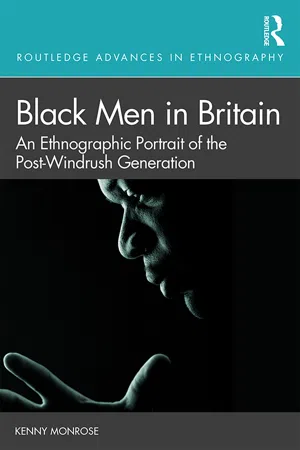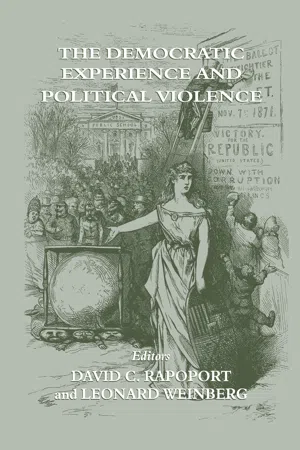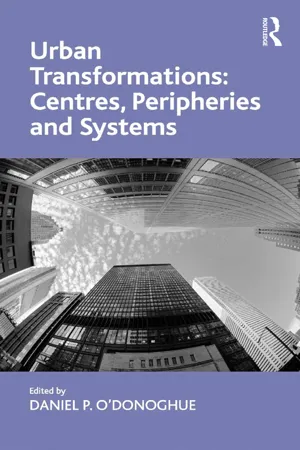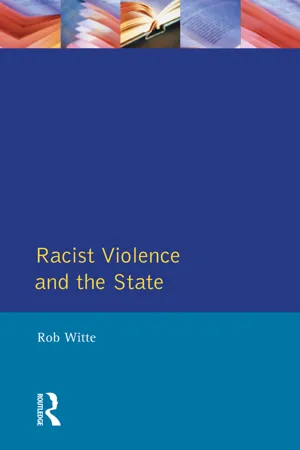History
Race Riots
Race riots refer to violent civil disturbances that occur between different racial groups within a community or society. These conflicts often stem from underlying racial tensions, discrimination, and socioeconomic disparities. Race riots have been a recurring phenomenon throughout history, with notable examples including the Tulsa race massacre in 1921 and the Los Angeles riots in 1992.
Written by Perlego with AI-assistance
Related key terms
5 Key excerpts on "Race Riots"
- eBook - ePub
Black Men in Britain
An Ethnographic Portrait of the Post-Windrush Generation
- Kenny Monrose(Author)
- 2019(Publication Date)
- Routledge(Publisher)
Unlike incidents involving race, however, such incidents are habitually framed within the public imagination as disputes, demonstrations or at their very worst skirmishes. An example is the representation of the carnage that blighted towns such as Carlisle, Stockton, Wellington, Telford, North Shields, Newcastle and Sunderland in the 1990s: the events were not classified as riots but merely as heavy incidents of antisocial behaviour. In contrast, similar incidents of social unrest that occur in heavily populated minority ethnic areas transcend from ‘disturbances’ to being labelled full-scale Race Riots. 12 Observe the manner in which the riots in Toxteth in Liverpool, and years later in Burnley in Lancashire, were presented (Lea, 2002). The thinly veiled subtext that typically lies beneath the definition of such events becomes transparent to those who can decipher the cryptic inscriptions of the media’s propaganda machine, which make these events seem as if they were only about poor policing, when in truth they were equally about racial discrimination. Suffice to say that, in the imagination of the British news media, the majority group do not riot – minority ethnic groups do. The earliest documented violent conflict of note involving black people in Britain occurred in Cardiff in 1919. The ‘Cardiff Negroland Conflicts’ were the first mass black declaration of resistance to the violent racism they were subject to. After the First World War, Britain experienced heightened levels of unemployment and homelessness, compounded by poor living conditions. As is common at such times, those of visible difference were held to account and blamed for the economic demise of the nation (Dabydeen et al., 2010; Fryer, 2010). As a result of this indictment, racially motivated attacks took place in a number of British port towns such as Liverpool and Exeter, but more potently in Cardiff - eBook - ePub
- David C. Rapoport, Leonard Weinberg(Authors)
- 2013(Publication Date)
- Routledge(Publisher)
Riots, like forest fires, start from preconditions. As the ability of fires to grow and spread and resist containment are a function of the abilities and resources at the disposal of firefighters, so too the ability of riots to grow, expand and persist is a function of the resources at the disposal of the police and their willingness to use them. Even the Kerner Commission report noted that a common pattern of violence usually began with rioters testing the waters to see how the police would react. When it became clear that the police would not bring enough force to deal effectively with the initial acts of violence, the violence grew in scope, duration, intensity and by the number of those subsequently emboldened to engage in such acts. 32 Every society has an aggrieved element. The willingness and ability of the aggrieved to go into the streets and precipitate acts of civil disorder and bring them to a point where they can virtually bring an entire city to its knees and close its international airport to commerce, as the Rodney King riot did in Los Angeles, is largely a function of the intrusion of democratic politics and interest group sensitivities on the police power. Nothing explains the virulence of the 1992 Los Angeles riots as does the failure of police countermeasures. Where the police power of the state was either prevented from acting, or where it sided with the rioters, civil disorder often turned to revolution. Contemporary experiences from Iran and the Philippines illustrate the inability or unwillingness of the police and military to put down riots, and allowing them to evolve into acts of revolution. The same case can be made for the collapse of the bourgeois government that retreated to the Winter Palace in St Petersburg in 1917. Riots are not a single event but a series of events sliced up into temporal, psychological, geographic and political dimensions - Daniel P. O'Donoghue(Author)
- 2016(Publication Date)
- Routledge(Publisher)
Chapter 8Riots by a Growing Social Periphery? Interpreting the 2011 Urban Riots in England
Wayne K.D. DaviesIntroduction
The last few years have seen a dramatic increase in the number and scale of demonstrations and protest movements in cities, making them one of the new transforming elements of our society and urban places. Historically, protests in cities are far from new. But this accelerating trend for people with grievances to “take to the streets” illustrates new levels of frustration with existing social and political conditions, in which other forms of resolution of their problems have failed. Some protests have suddenly turned into riots. These are crowd events characterized by violence against authority, property and people, many injuries and often deaths (Canetti, 1974; Hernon, 2006). However, there is a category of riots that initially seem without purpose, in the sense that the violence and destruction seem to lack any overt political, social or ethnic cause. At first sight, the traumatic four nights of looting, violence and arson in over 50 different urban locations in England in August 2011 seem to be one of these purposeless types of riots. They seemed to be carried out as acts of rage and wanton destruction, with participants apparently rejecting the basic norms of society – or were prepared to ignore these norms in the heat of the riot. Since the outbreaks were not accompanied by the signs that characterize political or social protests, it would seem appropriate, at least initially, to label them as examples of nihilistic riots – different from riots that developed from explicit political, social, ethnic or religious causes raised before or during the violence. However, the absence of signs of visible causes during the riots does not necessarily mean there were no motivations, other than pure destruction and greed, for as Martin Luther King once observed: “a riot is the language of the unheard.” So the frustrations of the rioters may lead them to violence and mayhem, given their inability to be “heard” in any other way. This perspective provides a note of caution about attributing motives without searching for the reasons for these outbreaks and leads to explanations from the Social Identity school of crowd behaviour. This study briefly reviews the progress and background causes of the riots. But instead of arguing for the primacy of one or two features, the “plural grounding” approach advocated by Sen (2009) which suggests that multiple causes are likely to underlie complex events. It is argued that two main sets of explanatory issues are involved: one involves immediate causes, such as the decision and willingness of people to participate in the riot and the effectiveness of policing; a second identifies underlying causes stemming from regressive socio-economic changes that have taken place in Britain. Just as economic changes have led to greater regional disparities in the country, so these riots indicate the growth of a disadvantaged social periphery that includes individuals whose different morality makes them capable of riotous behaviour.- eBook - ePub
Reading the Riot Act
Reflections on the 2011 urban disorders in England
- Rupa Huq MP(Author)
- 2018(Publication Date)
- Routledge(Publisher)
Yet, the various commentaries have all implied other starting points – almost no one argues that the killing of Duggan is the very beginning. This terrible incident may have been the immediate spark, but the orthodoxies of riot analysis remind us that the ostensible trigger is a reminder or reference to longer standing grievances or tensions. The point of interest, then, is not so much why this incident ignites this chain of reactions, but why so many other incidents do not. There has been no shortage of police killings in recent years – among them, Kingsley Burrell and Demetre Fraser in Birmingham, Anthony Grainger in Manchester and Smiley Culture in his own home, a death that caused a great deal of concern and protest in Caribbean and other communities.Farrar argues persuasively that we need to learn a more nuanced language and analytic framework to understand the varieties of violent urban protest that are grouped under the term “riot” and considers what can be learned and reworked from scholarly attempts to place the event of “riot” in a larger social and historical context (Farrar 2009, pp. 103–118). Yet, even these attempts to place unrest in a wider context of ongoing social relations can tend towards stock explanations. If we decide that the significance of events cannot be discerned through attention to uniquely remarkable incidents, then the longer contextual narratives veer towards the stories that have already been told. In Britain, this can mean that riots are about race – and, conversely, the street unrest of markedly white groups, say in relation to football, is not a “riot”.A painful demonstration of these racialised codings was seen in the patterns of sentencing following disturbances in Bradford in 2001. Here, the proposal to allow the British National Party to march through predominantly Asian neighbourhoods of Bradford led to local resistance, with young Asian men occupying their local streets as a mark of self-defence. Disturbances followed in both Asian and white neighbourhoods, with animosity directed towards the police, yet only Asian men were charged under the terms of “riot” and given the disproportionately long sentences that are enabled by that definition of disorder. White participants from neighbouring areas were charged with lesser offences under the rubric of public order (for more on the disturbances in Bradford, see Bagguley and Hussain). - eBook - ePub
Racist Violence and the State
A comparative Analysis of Britain, France and the Netherlands
- Rob Witte(Author)
- 2014(Publication Date)
- Routledge(Publisher)
Enoch Powell and some of his supporters, both in Parliament and in the media, claimed the riots proved their arguments, namely that the number of black migrants in Britain inevitably would cause tension and bloodshed. After the Bristol riots of 1980, the main discussions were about the question of whether these were ‘Race Riots’. In July 1981, this discussion was transformed to the representation of the riots as being ‘racial’ or at least the result of bad relations between the police and black youths.This transformation was important, because mainstream explanations of and responses to these riots as a threatening element in British society in the 1980s were implicit in the symbolic political language used. The notion of ‘Race Riots’ in 1980 had specific references to ‘the American model’ (read: the American-like future) and had established a link between black youth and street violence. The notion of ‘racial riots’ creates an image of riots in which ‘race’ somehow was a central variable or even the main one (Solomos, 1989: 106). Racism hardly constituted an issue in the debate.The fear of Britain sliding towards a violent society had attracted much attention. According to many commentators, lawlessness and violence were threatening to undermine traditional British values and institutions. In several parliamentary meetings, these supposed threats were discussed at length, and the maintenance of law and order received high priority on the formal agenda. ‘Law and order’ as a central issue, the perceived threat of street violence to the English ‘way of life’ and the alleged links with ‘black youth’ highlighted ‘the symbolic evocation of the re-establishment of order as the main concern of official language during this period’ (Solomos, 1989: 109).A number of responses related the riots to social factors. In parliamentary debates, the Labour opposition referred to a correlation between social and economic deprivation. According to this point of view, bad housing, a lack of social, cultural and welfare services, poor educational opportunities, high (youth) unemployment and social disarray were perceived to be the most important causes of the riots. In response, Home Secretary Whitelaw and Prime Minister Thatcher admitted that the circumstances in many inner cities were bad. They both, however, denied any assertion that these circumstances were the cause of the riots. Therefore, the main government response consisted of reinforcing the police and improving training facilities so that the police were better prepared.
Learn about this page
Index pages curate the most relevant extracts from our library of academic textbooks. They’ve been created using an in-house natural language model (NLM), each adding context and meaning to key research topics.




